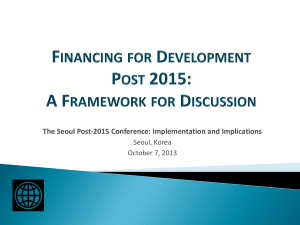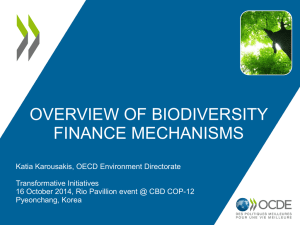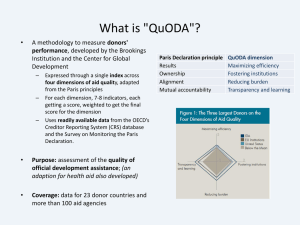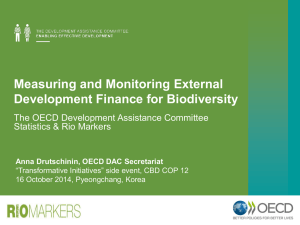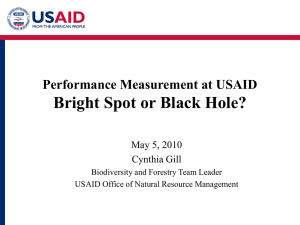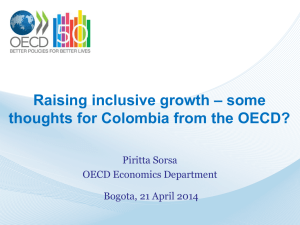Which sectors are receiving biodiversity
advertisement
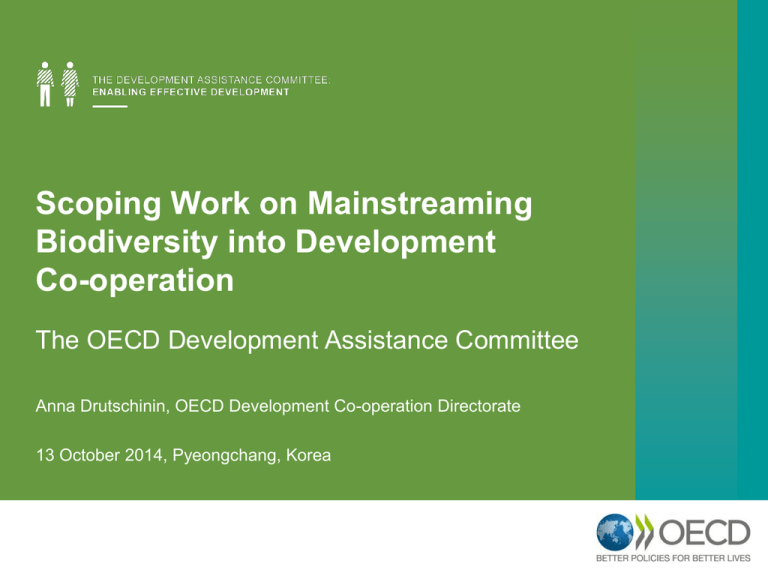
Scoping Work on Mainstreaming Biodiversity into Development Co-operation The OECD Development Assistance Committee Anna Drutschinin, OECD Development Co-operation Directorate 13 October 2014, Pyeongchang, Korea Outline of presentation • Trends in biodiversity-related aid – How much bilateral aid is flowing to biodiversity and how does it support other objectives? – What sectors and countries are top recipients? • Development assistance support for capacitybuilding • Development assistance to partner countries to mainstream biodiversity • Development co-operation agency practices and strategies to mainstream biodiversity How much bilateral aid is flowing to biodiversity? Trends in biodiversity-related aid, three-year averages 2004-2012, bilateral commitments, USD billion, constant 2012 prices Principal Significant % of total ODA 5% USD billion 5 4% 4 3% 3 2% 2 1% 1 0 Share of total ODA commitments 6 0% 2004-06 2007-09 2010-12 Source: OECD DAC Statistics, October 2014 • Bilateral biodiversity-related aid commitments by OECD DAC members reached USD 5.6 billion per year in 2010-12, representing 4% of total bilateral aid and 4% of total activities. Lower bound (aid targeting biodiversity as a principal objective) = USD 2.3bn • Development co-operation providers are increasingly targeting environmental synergies and co-benefits with their aid. In 2010-12, of total biodiversity-related bilateral aid, 82% also targets climate change (adaptation, mitigation or both) and/or desertification. • Which sectors are receiving biodiversity-related aid? Five main sectors receiving biodiversity-related aid Average 2010-12, bilateral commitments, USD billion, constant 2012 prices Significant Share of total ODA commitments 37% 2.5 Rural Development 7% USD billion 2.0 1.5 20% Agriculture 37% 15% 1.0 40% Fishing 6% 35% 30% 25% Forestry 50% 20% 15% 10% 0.5 3% 2% 0.0 5% 0% General Environmental Protection Agriculture, Forestry, Fishing and Water Supply and Sanitation Rural Development Multisector Energy Share of total ODA commitments to sector targeting biodiversity Principal Source: OECD DAC Statistics, October 2014 • • Aid is concentrated: Over 80% of biodiversity-related aid in 2010-12 was in the sectors of general environment protection, agriculture, forestry, fishing, rural development, and water supply and sanitation Biodiversity-related aid represents a significant share of total aid to forestry (71%), fishing (39%), general environmental protection (37%), agriculture (16%) and water supply and sanitation (15%). Which countries are receiving biodiversity-related aid? Top ten countries receiving biodiversity-related aid Average 2010-12, bilateral commitments, USD billion, constant 2012 prices Country Brazil India Vietnam Turkey Indonesia Ethiopia China Peru Guyana Kenya USD million 527 356 168 157 155 116 110 109 97 78 Share of total biodiversityrelated ODA 9% 6% 3% 3% 3% 2% 2% 2% 2% 1% Source: OECD DAC Statistics, October 2014 • In absolute terms, biodiversity-related aid concentrated in Brazil and India. • In relative terms, biodiversity the greatest focus of aid commitments to Guyana (61% of bilateral aid had a biodiversity-related objective in 201012), Brazil (33%), Maldives (29%), Mauritius (20%) and Honduras (19%) Development assistance support for capacity building • Estimated bilateral support for biodiversity-related capacity building increased from approximately 25% of total bilateral biodiversityrelated ODA in 2004-06 (USD 0.8 billion per year) to approximately 44% in 2010-12 (USD 2.5 billion per year). – Roughly equal across all income groups and regions (Europe is slightly higher (56%), Oceania is slightly lower (34%)). – Predominantly targeting biodiversity as a significant objective (70%) – Predominantly delivered through grants (88%) – 85% supporting policy and administrative management (especially in environment and forestry, but also in agriculture, water, fishing, tourism, trade) – 12% supports biodiversity-related research, education and training Development assistance to partner countries to mainstream biodiversity • Financial and technical support to employ the mainstreaming policies and tools available – Belgium: communication, education, awareness through national Clearing House Mechanisms in Benin, Niger – Germany: technical support and training on Strategic Environmental Assessment in in mining and biofuels in Namibia – France: supporting Fair Trade Africa certification scheme to integrate biodiversity considerations into production systems in West African countries Development co-operation agency practices and strategies to mainstream biodiversity • Some agencies have introduced compulsory screening of their aid projects for impacts on biodiversity – e.g. Australia, Austria, EU, France, Germany, Japan, Sweden, US – If potential impact on biodiversity detected: compulsory Environmental Impact Assessment/Environment Management Plan • More development co-operation agencies are developing biodiversity strategies/policies in which mainstreaming is a key pillar – e.g. EU, France, Germany, US OECD DAC CRS Rio marker statistics, analysis & access to data http://oe.cd/RM Biodiversity-related statistics and analysis http://www.oecd.org/dac/stats/biodiversity.htm Rio markers training workshop: www.oecd.org/dac/environment-development/trainingworkshop.htm OECD Environment and Development Homepage www.oecd.org/dac/environment-development Rio Markers: Stephanie.Ockenden@OECD.org and Valerie.Gaveau@OECD.org Biodiversity and Development: Anna.Drutschinin@oecd.org and Juan.CasadoAsensio@oecd.org



